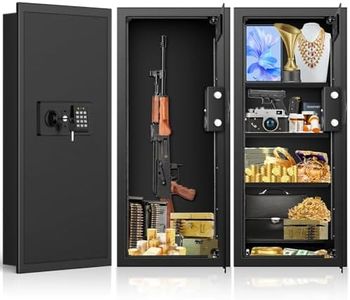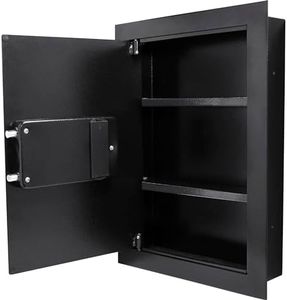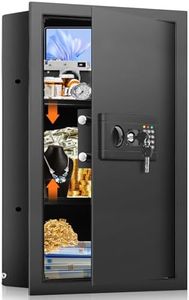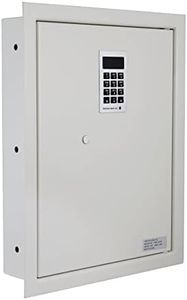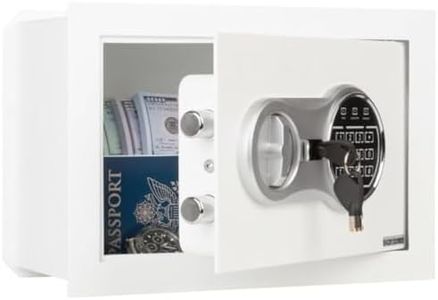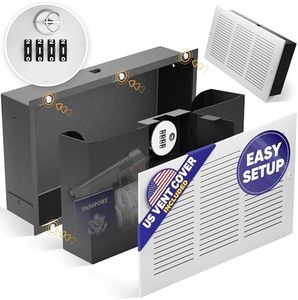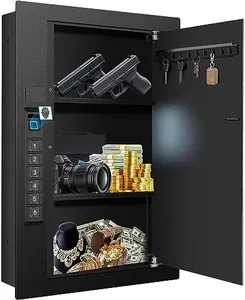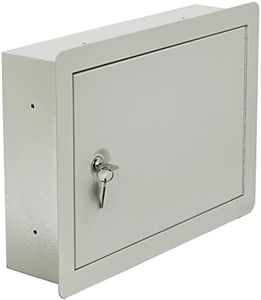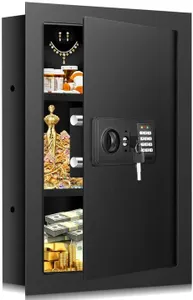We Use CookiesWe use cookies to enhance the security, performance,
functionality and for analytical and promotional activities. By continuing to browse this site you
are agreeing to our privacy policy
10 Best In Wall Safe
From leading brands and best sellers available on the web.Buying Guide for the Best In Wall Safe
Choosing an in-wall safe can offer both security and convenience for storing valuables, important documents, or even firearms out of sight in your home or office. The best in-wall safe for you depends on what you plan to store, where you want to install it, and how often you’ll need access. Think about your space, the type of items you want to protect, and how important factors like fire resistance or quick access are for your needs. Focusing on the core specifications will help you select a safe that fits your lifestyle and requirements.Size and DepthSize and depth refer to the external and internal dimensions of the safe, indicating how much space you have to store your belongings and whether the safe will fit between the studs in your wall. This spec matters because a larger or deeper safe allows you to store bigger or multiple items, but it also requires a suitable wall space for installation. Typically, in-wall safes are designed to fit between standard wall studs (about 16 inches apart). Some are shallow and hide easily behind pictures, while deeper safes can hold bulkier valuables but might protrude more or need thicker walls. Think about what you plan to store—just documents and cash need little space, but jewelry boxes, handguns, or electronics require more depth. Measure your wall cavity before choosing, and remember to leave space for the door mechanism.
Locking MechanismThe locking mechanism is how you open the safe, and it’s crucial for both security and convenience. Common options include mechanical combination dials, digital keypads, biometric (fingerprint) scanners, or simple keyed locks. Mechanical dials are reliable and don't require batteries, but take longer to open and can be tricky if you forget the combination. Digital keypads offer quick, easy access, but need batteries and could be vulnerable to power failures. Biometric locks provide fast, personalized access, making them ideal if you need to open your safe frequently, but quality varies and cheap fingerprint locks may not be totally secure. A keyed lock is simple, but you’ll need to keep track of the key. Consider how often you’ll need to open your safe and who should have access before choosing the lock type that best matches your needs.
Security Features and Steel ThicknessSecurity features include things like the thickness of the steel used, reinforced doors, anti-pry bars, and the number and size of locking bolts. Thicker steel and stronger construction make it harder for someone to force the safe open or cut it out of the wall. Basic models might use thinner steel (under 2mm) suitable mainly for keeping things hidden or deterring quick thefts, while higher-end safes use thicker steel (over 4mm) and extra reinforcements to resist physical attacks. Added locking bolts and anti-pry tabs make break-ins much tougher. Think about whether you’re more concerned with keeping items hidden or truly secure—if you’re storing small valuables, lighter construction can suffice, but for more valuable or risky items, prioritize robust build and solid bolt systems.
Fire and Water ResistanceFire and water resistance refers to a safe’s ability to protect your belongings in case of disaster. Not all in-wall safes have this feature, but some are designed to withstand heat or moisture for a certain period (like 30 or 60 minutes resistance to fire up to specific temperatures, or limited waterproofing). This matters if you want to protect documents, cash, or data from fire or flooding. Values usually segment into “none,” “limited” (basic fire lining), and “full” resistance (lab-tested for a set time at high heat or with water exposure). Decide if this protection is important for you based on what you’ll store and your home’s risk factors (for example, living in fire-prone regions or flood areas), and look for certification if it’s a priority.
Installation RequirementsInstallation requirements detail how the safe is designed to be mounted, including what wall types it’s compatible with and if professional installation is advised. Some safes are designed for easy DIY mounting, with pre-drilled holes and clear instructions, while others may need tools or drilling into studs, which can be more challenging. Check if your chosen location has the right spacing between studs and if there are any electrical or plumbing obstructions behind the wall. If you’re not comfortable with tools, consider whether you’ll need an installer. For heavier or larger safes, secure anchoring is especially important to prevent easy removal by thieves.
Accessibility and ConcealmentAccessibility means how easy it is to get to your safe and access its contents, while concealment refers to how well it can be hidden from view. Some safes are made to be hidden behind picture frames, mirrors, or furniture, while others have recessed doors for a more flush fit. If you want quick and frequent access, pick a model that sits at a comfortable height and has a simple locking mechanism; for maximum secrecy, prioritize models that blend in with your wall or decor and consider where you’ll place them (for example, inside closets or behind artwork). Decide based on whether your top priority is stealth or regular, easy access.
